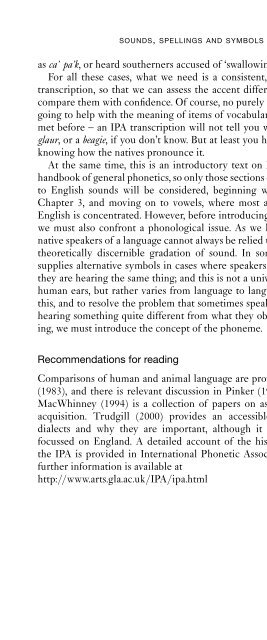April McMahon
April McMahon
April McMahon
- No tags were found...
You also want an ePaper? Increase the reach of your titles
YUMPU automatically turns print PDFs into web optimized ePapers that Google loves.
DESCRIBING ENGLISH CONSONANTS 31A. BILABIALFor a bilabial sound, the active articulator is the bottom lip, and thepassive articulator is the top lip./p/ pie voiceless bilabial plosive/b/ by voiced bilabial plosive/m/ my voiced bilabial nasalThere is at least one further English phoneme which to an extent fitsunder this heading: this is the approximant /w/ in wet. In producing [w],the lips are certainly approximated, though not enough to cause frictionor obstruct the airflow; but you should be able to feel that the back ofyour tongue is also bunched up. This additional articulation takes placeat the velum, so that [w] is not simply a labial sound, but a labial-velarone. In some accents of English, notably those spoken in Scotland andNew Zealand, this /w/ contrasts with //, the voiceless labial-velarfricative, which tends to occur in words spelled . If you have thesame pronunciation for witch and which, or Wales and whales, then youhave only /w/; if these are consistently different for you, then theseminimal pairs establish a contrast of /w/ and //./w/ witch voiced labial-velar approximant// which voiceless labial-velar fricativeB. LABIO-DENTALFor labio-dental sounds, the active articulator is again the bottom lip, butthis time it moves up to the top front teeth. Note that these soundsare labio-dental, while /w/ and // are labial-velar, because in the firstcase, articulation takes place only at a single location, while in thesecond, there are two separate, simultaneous articulations./f/ fat voiceless labio-dental fricative/v/ vat voiced labio-dental fricativeC. DENTALIn most English sounds, and most speech sounds in general, the activearticulator is part of the tongue; to avoid confusion, places of articulationwhere the tongue is involved are therefore generally called afterthe passive articulator. For the two dental fricatives, it follows that thepassive articulator is the top front teeth; the active articulator is the tipof the tongue. The tongue itself is conventionally divided into thetip (the very front); the blade (just behind the blade, and lying oppositethe alveolar ridge); the front (just behind the blade, and lying oppositethe hard palate); the back (behind the front, and lying opposite the
















